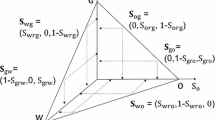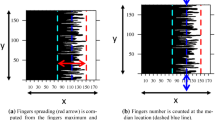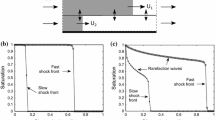Abstract
Displacement of a viscous fluid by a lower viscosity immiscible fluid (such as waterflood of a viscous oil) in a porous medium is unstable. The displacement front generates viscous fingers which lead to low oil recovery efficiency. These fingers are much smaller in width than typical reservoir simulation grid blocks, and capturing their effect in reservoir simulation is important. A dimensionless scaling group (viscous finger number) had been suggested in the past, which has a power-law relationship with the breakthrough recovery and cumulative recovery in unstable core floods. The relative permeability used in large grid block simulations had been modified to so-called pseudo-relative permeability on the basis of the dimensionless group, thus incorporating the effect of fingers in waterflood predictions. However, the previous proposed models were constructed from experiments in only water-wet rocks. This paper extends the recent viscous fingering models to oil-wet systems. Sandstone cores were treated to alter the wettability to oil-wet. Adverse viscosity water floods were performed in oil-wet cores. Viscosity ratio, velocity and diameter were varied. It is shown that the previously developed viscous finger number does not work for the oil-wet experiments. The correlating dimensionless number is modified for oil-wet systems; it is also different from the dimensionless group identified by Peters and Flock (Soc Petroleum Eng, 1981. doi:10.2118/8371-PA) for oil-wet cores. A pseudo-relative permeability model has been developed for oil-wet cores. Corefloods have been matched by the new pseudo-relative permeability model to determine the model parameters. This pseudo-relative permeability model can be used in reservoir simulations of water and polymer floods in viscous oil-wet reservoirs.














Similar content being viewed by others
References
Anderson, W.G.: Wettability literature survey part 5: the effects of wettability on relative permeability. Soc. Pet. Eng. (1987). doi:10.2118/16323-PA
Araktingi, U.G., Orr Jr., F.M.: Viscous fingering in heterogeneous porous media. Soc. Pet. Eng. (1993). doi:10.2118/18095-PA
Blunt, M.J., Barker, J.W., Rubin, B., Mansfield, M., Culverwell, I.D., Christie, M.A.: Predictive theory for viscous fingering in compositional displacement. Soc. Pet. Eng. (1994). doi:10.2118/24129-PA
Booth, R.J.S.: On the growth of mixing zone in miscible viscous fingering. J. Fluid Mech. 655, 527–539 (2010)
Buckley, J.S.: Mechanisms and consequences of wettability alteration by crude oil. Ph.D. Dissertation, Heriot-Watt University (1996)
Christie, M.A., Muggeridge, A.H., Barley, J.J.: 3D simulation of viscous fingering and WAG schemes. Soc. Pet. Eng. (1993). doi:10.2118/21238-PA
Chuoke, R.L., van Meurs, P., van der Poel, C.: The instability of slow, immiscible, viscous liquid–liquid displacements in permeable media. Pet. Trans. AIME 216, 194 (1959)
Delamaide, E., Zaitoun, A., Renard, G., Tabary, R.: Pelican lake field: first successful application of polymer flooding in a heavy-oil reservoir. SPE Reservoir Eval. Eng. 17(03), 340–354 (2014)
DiCarlo, D.A.: Stability of gravity-driven multiphase flow in porous media: 40 years of advancements. Water Resour. Res. 49, 4531–4544 (2013). doi:10.1002/wrcr.20359
Doorwar, S.: Understanding unstable immiscible displacement in porous media. Ph.D. Dissertation, The University of Texas at Austin (2015)
Doorwar, S., Mohanty, K.K.: Extension of the dielectric breakdown model for simulation of viscous fingering at finite viscosity ratios. Phys. Rev. E 90, 013028 (2014)
Doorwar, S., Mohanty, K.K.: Fingering function for unstable immiscible flows. SPE J. (2016). doi:10.2118/173290-PA
Fayers, F.J.: An approximate model with physically interpretable parameters for representing miscible viscous fingering. Soc. Pet. Eng. (1988). doi:10.2118/13166-PA
Homsy, G.M.: Viscous fingering in porous media. Annu. Rev. Fluid Mech. 19, 271–311 (1987)
Jha, B., Cueto-Felgueroso, L., Juanes, R.: Quantifying mixing in viscously unstable porous media flows. Phys. Rev. E 84(6), 066312 (2011a)
Jha, B., Cueto-Felgueroso, L., Juanes, R.: Fluid mixing from viscous fingering. Phys. Rev. Lett. 106(19), 194502 (2011b)
King, M.J., Scher, H.: Probabilistic stability analysis of multiphase flow in porous media.In: SPE-14366-MS Presented in the SPE Annual Technical Conference and Exhibition, Las Vegas, 22–26 Sept 1985
Koh, H., Lee, V.B., Pope, G.A.: Experimental investigation of the effect of polymers on residual oil saturation. Soc. Pet. Eng. (2016). doi:10.2118/179683-MS
Koval, E.J.: A method for predicting the performance of unstable miscible displacement in heterogeneous media. Soc. Pet. Eng. (1963). doi:10.2118/450-PA
Luo, H., Mohanty, K.K., Delshad, M.: Modeling and upscaling unstable water and polymer floods: dynamic characterization of the effective finger zone. SPE J. (2016). doi:10.2118/179648-PA
Luo, H., Delshad, M., Pope, G.A., Mohanty, K.K.: Interactions between viscous fingering and channeling for unstable water/polymer floods in heavy oil reservoirs. Soc. Pet. Eng. (2017). doi:10.2118/182649-MS
Pavone, D.: Observations and correlations for immiscible viscous-fingering experiments. Soc. Pet. Eng. (1992). doi:10.2118/19670-PA
Peters, E.J., Flock, D.L.: The onset of instability during two-phase immiscible displacement in porous media. Soc. Pet. Eng. (1981). doi:10.2118/8371-PA
Riaz, A., Tchelepi, H.A.: Numerical simulation of immiscible two-phase flow in porous media. Phys. Fluids 18(1), 014104 (2006)
Sherwood, J.D., Nittmann, J.: Gradient governed growth: the effect of viscosity ratio on stochastic simulations of the Saffman-Taylor instability. J. Phys. 47(1), 15–22 (1986)
Tavassoli, S., Lu, J., Pope, G.A., Sepehrnoori, K.: Investigation of the critical velocity required for a gravity-stable surfactant flood. Soc. Pet. Eng. (2014). doi:10.2118/163624-PA
Todd, M.R., Longstaff, W.J.: The development, testing, and application of a numerical simulator for predicting miscible flood performance. Soc. Pet. Eng. (1972). doi:10.2118/3484-PA
Vives, M.T., Chang, Y.C., Mohanty, K.K.: Effect of wettability on adverse-mobility immiscible floods. Soc. Pet. Eng. (1999). doi:10.2118/57597-PA
Worawutthichanyakul, T.: Unstable immiscible displacement study in oil-wet rocks. MS Thesis, The University of Texas at Austin (2016)
Yortsos, Y.C., Huang, A.B.: Linear stability analysis of immiscible displacement including continuously changing mobility and capillary effects: part I-simple basic flow profiles. Soc. Pet. Eng. Res. Eng. 1, 378 (1986)
Yuan, Q., Azaiez, J.: Miscible displacements in porous media with time-dependent injection velocities. Transp. Porous Media 104, 57–76 (2014). doi:10.1007/s11242-014-0320-9
Acknowledgements
This work was partially supported by the Chemical EOR Industrial Affiliates Program of the Center for Petroleum and Geosystems Engineering.
Author information
Authors and Affiliations
Corresponding author
Rights and permissions
About this article
Cite this article
Worawutthichanyakul, T., Mohanty, K.K. Unstable Immiscible Displacements in Oil-Wet Rocks. Transp Porous Med 119, 205–223 (2017). https://doi.org/10.1007/s11242-017-0880-6
Received:
Accepted:
Published:
Issue Date:
DOI: https://doi.org/10.1007/s11242-017-0880-6




